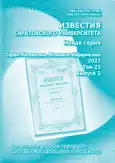Hierarchical risk analysis of unmanned aerial vehicle threat models
- Autores: Aralbaev T.Z.1, Galimov R.R.1, Getman M.A.1, Klindukh O.V.1
-
Afiliações:
- Orenburg State University
- Edição: Volume 23, Nº 2 (2023)
- Páginas: 241-252
- Seção: Articles
- URL: https://journals.rcsi.science/1816-9791/article/view/250846
- DOI: https://doi.org/10.18500/1816-9791-2023-23-2-241-252
- EDN: https://elibrary.ru/QTWFDI
- ID: 250846
Citar
Texto integral
Resumo
Sobre autores
Tashbulat Aralbaev
Orenburg State UniversityRussia, 460352, Orenburg, pr. Pobedy, 13
Rinat Galimov
Orenburg State UniversityRussia, 460352, Orenburg, pr. Pobedy, 13
Maria Getman
Orenburg State UniversityRussia, 460352, Orenburg, pr. Pobedy, 13
Oksana Klindukh
Orenburg State UniversityRussia, 460352, Orenburg, pr. Pobedy, 13
Bibliografia
- Винограденко А. М., Ладонкин О. В., Юров А. С. Система мониторинга технического состояния подвижных объектов военного назначения с использованием беспроводных технологий // T-Comm: Телекоммуникации и транспорт. 2015. Т. 9, № 1. C. 51–55. EDN: TILBZP
- Tang Miaomiao, Wang Changzhou, Zhong Zhi. Unmanned aerial vehicle (UAV) monitoring system based on integrated responder and response and ADS-B OUT/IN methods of UAV monitoring system. Patent China. № CN109727493A. 2019.
- Михайлов В. В., Самсонов А. В. Критерии эффективности беспилотных летательных аппаратов в решении задач мониторинга окружающей среды // Проблемы обеспечения безопасности при ликвидации последствий чрезвычайных ситуаций. 2013. № 1–1 (2). C. 365–369. EDN: WDNQZF
- Петренко С. А., Симонов С. В. Управление информационными рисками. Экономически оправданная безопасность. Москва : Компания АйТи ; ДМК Пресс, 2004. 384 с. (Информационные технологии для инженеров).
- Чекина Е. В., Михеев С. В., Остроглазов Н. А., Михеева Т. И. Метод построения маршрутов беспилотного летательного аппарата на интерактивной электронной карте // Информационные технологии интеллектуальной поддержки принятия решений : труды VII Всероссийской научной конференции (с приглашением зарубежных ученых) : в 3 т. Т. 1. Уфа : УГАТУ, 2019. C. 1–6. EDN: UXZUQC
- Свидетельство о государственной регистрации программы для ЭВМ № 2022613608 Российская Федерация. Метод иерархического анализа рисков моделей угроз мобильного объекта информатизации : № 2022612182 : заявл. 21.02.2022 : опубл. 14.03.2022 / Т. З. Аралбаев, Р. Р. Галимов ; заявитель федеральное государственное бюджетное образовательное учреждение высшего образования «Оренбургский государственный университет». EDN: XXOTXN
- Аралбаев Т. З., Гетьман М. А. Оптимизация защиты беспилотного летательного аппарата в задаче мониторинга распределенных объектов нефтедобычи // Polish Journal of Science. 2021. № 39. P. 36–40. EDN: URBBNS
Arquivos suplementares










